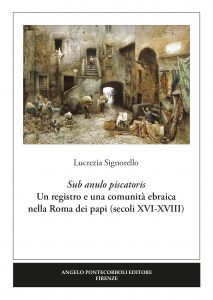Life as a Jew in Papal Rome
 Archives are our historical memory, and no one knows better than Lucrezia Signorello. A young Italian scholar, in 2017, she obtained a research scholarship from the Italian Jewish Heritage Foundation to explore, in collaboration with the Rome Jewish Community and its historical archive, the history of Jews in Rome between the 16th and 18th century. Her research is now a book titled Sub anulo piscatoris: un registro e una comunità ebraica nella Roma dei papi – Secoli XVI-XVIII (Sub anulo piscatoris: a register and a Jewish community in Papal Rome – 16th and 18th centuries), recently released by the publisher Angelo Pontecorboli.
Archives are our historical memory, and no one knows better than Lucrezia Signorello. A young Italian scholar, in 2017, she obtained a research scholarship from the Italian Jewish Heritage Foundation to explore, in collaboration with the Rome Jewish Community and its historical archive, the history of Jews in Rome between the 16th and 18th century. Her research is now a book titled Sub anulo piscatoris: un registro e una comunità ebraica nella Roma dei papi – Secoli XVI-XVIII (Sub anulo piscatoris: a register and a Jewish community in Papal Rome – 16th and 18th centuries), recently released by the publisher Angelo Pontecorboli.
Signorello’s work focuses on a modern age register, identified as 1H7 Register of ancient documents, which is written in Latin and Italian, with the inclusions of terms and names in Hebrew. Its collection of norms, trials, and memoirs conveys a lively image of the Jewish community life in 16-18th century Rome, offering a realistic, albeit partial, cross-section of a city and historical periods to its readers.
At the time the Jewish minority was a key part of the city’s make up, able to claim its well defined otherness in modern times. The archival material, which is analyzed and partially transcribed in the book testifies both to the need of the city government to govern the daily at times conflictual interactions between Christians and Jews in the streets and squares of the Papal State’s capital, as well as offering a glance into the customs, needs, defeats and victories of a group able to defend its role in society, even though it was often resisted and questioned. Drawing from ancient records, the book offers the reader both a tale of resilience and a lively depiction of the past.
